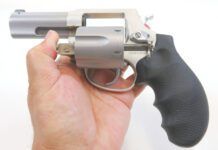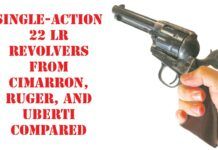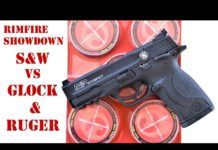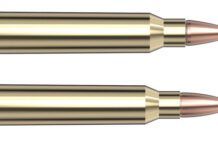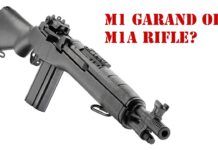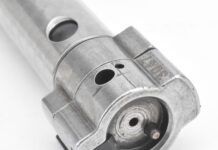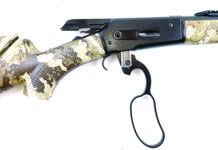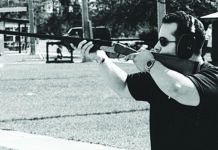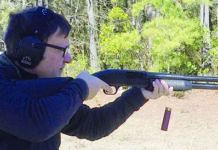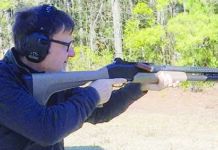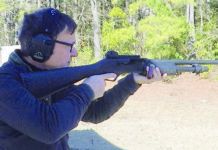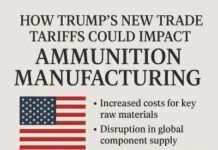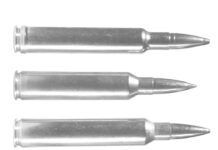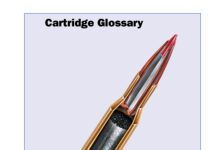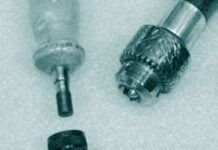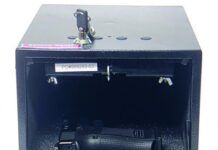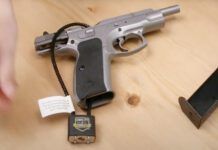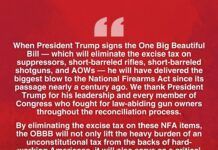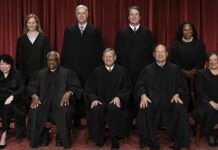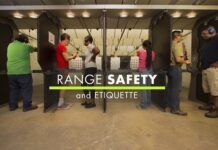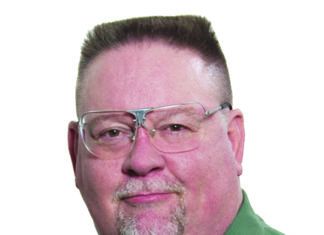| Action | Action is the term for the operating mechanism of a gun. It refers to the combination of moving parts that allow a shooter to load fire and unload a gun. |
| Adjustable Sights | Sights that allow vertical (elevation) and horizontal (windage) adjustments. |
| Aperture | The hole in a rear peep sight through which the shooter looks at the front sight and target. |
| Autoloading | An action of semi-automatic or self-loading operation. |
| Backstrap | The part of a handgun grip. Together with the frontstrap, it provides a mounting frame for the grips. |
| Barrel Length (BBL) | Measured from the muzzle to the standing breech in a break-open gun or to the bolt face in a bolt-action rifle, including the chamber. A revolver-barrel measurement does not include the cylinder, only the barrel itself. |
| Battery | The condition of a firearms breechblock in firing position. |
| Bead | A round sight normally used at the muzzle of a shotgun or the front sight of some rifles, in which the sight is viewed as a round bead on a narrow post. |
| Bedding | The fit and stability of a barreled action within a rifle stock. Often accomplished with shaped fiberglass or metal, as in an aluminum bedding block. |
| Bipod | A two-legged support for the front end of a rifle to stabilize the gun while shooting. |
| Black Powder | The earliest type of firearms propellant that has generally been replaced by smokeless powder except for use in muzzleloaders and older breechloading guns that demand its lower pressure levels. |
| Black Powder Rifle | A long arm that uses black powder (or black powder substitute) as the propellant, either in a black-powder cartridge or loaded separately into the rifle. |
| Blade Sight | Generally, the front sight of a rifle or handgun, seen by the shooter as a post. |
| Boat Tail | The shape of a bullet with a tapered base, designed to reduce air drag. |
| Bolt | A breechblock, generally circular in cross-section, that moves backward and forward to open or close the action. |
| Bolt Action | A type of firearm action in which the gun’s bolt is operated manually by the opening and closing of the breech (barrel) with a small handle, most commonly placed on the right-hand side of the gun (for right-handed users). As the handle is operated, the bolt is unlocked, the breech is opened, the spent shell casing is extracted and ejected, the firing pin is cocked (this occurs either on the opening or closing of the bolt, depending on design), and finally a new round/shell (if available) is placed into the breech and the bolt closed. Bolt-action firearms are most often rifles, but there are some bolt-action shotguns and a few handguns as well. |
| Bore | The interior of a firearm’s barrel, excluding the chamber. |
| Box Magazine | A removable storage device to hold cartridges and feed them. |
| Breech | The end of a barrel into which a cartridge is inserted. |
| Breech Plug | A device that screws into the barrel to close the breech of a muzzle-loading firearm. |
| Buckshot | Large-size lead shot pellets used in shotshells. Buckshot can range in size from #4 up to 000. |
| Bull Barrel | A barrel that has the same outside diameter its entire length. This type of barrel has the advantage of being very stiff, hence, it has a greater potential to be accurate. It has the disadvantage of being heavy. |
| Bullet | A single projectile fired from a rifle or handgun; either loaded from the muzzle or loaded into a cartridge. A single projectile fired from a shotgun is called a slug. |
| Butt | The rearmost portion of the stock that rests against the shoulder. |
| Buttplate | A hard plate that covers the butt end of the stock. |
| Caliber | A system of measurement for the internal bore diameter of a rifled-barreled firearm (rifle or pistol), generally measured in hundredths of an inch (e.g., .22) or millimeters (e.g. 6.5mm). |
| Carbine | A firearm similar to a rifle or musket. Many carbines, especially modern designs, were developed from rifles, being essentially shortened versions of full rifles firing the same ammunition, although often at a lower velocity. The shorter length and lighter weight of carbines makes them easier to handle in close-quarter situations, or when deploying from vehicles. The disadvantages of carbines are generally poorer long-range accuracy and shorter effective range. |
| Cartridge | A small usually cylindrical packet, containing a detonating primer, a powder charge, a load — either a single projectile for a rifle or a quantity of small pellets for a shotgun — and possibly some attendant wadding. |
| Case | The envelope (container) of a cartridge. For rifles and handguns, it is usually of brass or other metal; for shotguns it is usually of paper or plastic with a metal head and is more often called a “shell.” |
| Casehardening | “Mottled blue/green/brown colors on a shotgun or double rifle receiver, the by-product of a heat-treating process that incorporates carbon into the surface molecular structure of the steel, providing a hard-wearing surface without making the entire receiver brittle.” |
| Centerfire | “A cartridge, or firearm using a cartridge, with the primer in the center of the cartridge base.” |
| Cerakote | Cerakote is a Polymer-Ceramic Composite coating that can be applied to metals, plastics, polymers, and wood. The unique formulation used for Cerakote ceramic coating enhances a number of physical performance properties including abrasion/wear resistance, corrosion resistance, chemical resistance, impact strength, and hardness. This state-of-the-art coating technology out-performs any competitive coating in both laboratory settings and real-world applications. |
| Chamber | “An area at the breech end of a barrel, of about the diameter of the cartridge for which the gun was intended, and into which the cartridge is inserted. “ |
| Checkering | A regular pattern of fine grooves cut into the surface of a stock to aid in gripping a gun. |
| Cheekpiece | “A broad, flat, raised area on the side of a buttstock. “ |
| Choke | “A carefully measured constriction of the bore of a shotgun at the muzzle, designed to control the spread of the shot as it leaves the barrel. “ |
| Choke Tubes | “Short, interchangeable cylinders, of subtly different internal tapers, that screw into a threaded recess at the muzzle of a shotgun. “ |
| Cocking Indicators | Small devices attached to the internal hammer of a gun and visible from the exterior of the gun to show when gun is cocked and when it has been fired. |
| Comb | “The top of a gun’s stock, where a shooter rests their cheek when mounting a gun. “ |
| Compensator | A device attached to the muzzle of a firearm to reduce the upward movement of the muzzle brought about by recoil. |
| Cylinder | “A revolver part, cylindrical in shape, with firing chambers that rotate to align with the bore. “ |
| Derringer | A derringer is generally the smallest usable handgun of a given caliber. Derringers are also known as palm pistols. There have been many different designs over the years. |
| Double Action (DA) | An action type where the pulling the trigger both cocks and releases the hammer. |
| Ejector | A device for expelling a fired cartridge case from a firearm. |
| Elevation | Adjustment of the point of impact of a firearm in the vertical plane; the knob used on an iron sight or telescopic sight to raise or lower the point of impact. |
| Extractors | A device that pulls the cartridge out of the chamber. |
| Eye Relief | The distance your eye must be from the ocular lens and still get a full field of view. |
| Falling Block | A type of action used primarily for single-shot rifles, whereby some kind of lever actuates a breechblock, moving it downward in a vertical recess to expose the chamber. |
| Federal Firearms License (FFL) | A license that enables an individual or a company to engage in a business pertaining to the manufacture of firearms and ammunition or the interstate and intrastate sale of firearms. Holding an FFL to engage in certain such activities has been a legal requirement within the United States of America since the enactment of the Gun Control Act in 1968. |
| Feed | The process of moving live cartridges from the magazine of a firearm into the chamber. |
| Fiber-optic Sights | Sight that gathers ambient light. |
| Field of View (FOV) | The amount of area seen through your scope from right to left at 100 yards. |
| Firing Pin | The part on the gun that strikes the primer and causes it to ignite the cartridge. |
| Fixed 3-Dot Sight | On semi-automatic handguns, the most common type of enhancement is a bright white dot painted on the front sight near the top of the blade, and a dot on each side of the rear sight notch. In low lighting conditions, the front-sight dot is centered horizontally between the rear sight dots, with the target placed above the middle (front) dot. Some sight vendors offer differently colored dots for the front and rear sights. |
| Flash Suppressor | A device affixed to the muzzle of a firearm barrel, designed to minimize the bright flash caused by escaping hot gases and burning powder residue upon firing. |
| Floor Plate | Metal plate at the bottom of the magazine of a bolt action rifle. |
| Fluted Barrel | A rifle or pistol barrel which grooves have been milled into the barrel. These flutes help reduce barrel weight and increase surface area to help cool the barrel quicker. |
| Follower | A spring-loaded part of a firearm’s magazine that controls the cartridges in the magazine and presents them in the proper orientation to be fed into the chamber. |
| Forearm | The front part of a rifle or shotgun stock, when the stock is of two-piece design. |
| Forend | The stock section under the barrel, uses to help hold the firearm by the support hand. |
| Fouling | Metal or powder residue left in the bore of a firearm as a result of firing. |
| Front Strap | Front, metal, part of a handgun’s grip—which together with the backstrap, provides a mounting frame for the grip panels. |
| Full Metal Jacket | A type of bullet in which the lead core is encased in a copper jacket on the front and sides. The copper jacket may also include the base, but this is rarer. |
| Gauge | A system of measurement for the internal bore diameter of a smooth-bore firearm based on the diameter of each of that number of spherical lead balls whose total weight equals one pound. |
| Grains | A unit of weight (mass actually) used for measuring bullets and gunpowder. |
| Grip | The portion of the stock or pistol where you grasp the gun with your dominate or trigger hand. |
| Grooves | The cuts made in the bore of a firearm to produce rifling. |
| Hammer | A mechanical part that pivots on an axis and can be released by the trigger to go quickly forward to strike the firing pin. |
| Hammerless | A firearm with its hammer enclosed inside the action body; i.e. no visible hammer. |
| Handgun | A handgun is a firearm designed to be held and operated by one hand, with the other hand optionally supporting the shooting hand. This characteristic differentiates handguns as a general class of firearms from their larger counterparts: long guns such as rifles and shotguns (which are held in both hands and usually braced against the shoulder). Some handgun subtypes include derringers, single-shot pistols, revolvers, semi-automatic pistols, pepperboxes, and machine pistols. |
| Hollow Point (HP) | A type of expanding projectile that has a pit or hollowed out shape in its tip often intended to cause the projectile to expand upon impact with target. |
| Iron Sights | Metallic sights on a gun. The term is used to differentiate them from optical sights (scopes). |
| Jacket | The envelope enclosing the core of a bullet. |
| Jacketed Hollow Point (JHP) | A type of bullet similar to a Jacketed Soft Point, except that a portion of the nose cavity is hollowed out for greater bullet expansion. |
| Jacketed Soft Point (JSP) | A type of bullet with a soft lead core enclosed by a hard metal jacket (usually an alloy of copper), but with the nose section exposed to ensure bullet expansion. |
| Lands | The portion of the bore in a rifled barrel that protrudes into the bore itself. |
| Length Of Pull | The distance from trigger to the end of the gun’s buttstock. |
| Lever Action | A repeating firearm action operated by a lever beneath the grip. |
| Long Gun | The term long gun is used to describe classes of firearm with longer barrels than other classes. In small arms, a long gun is designed to be fired braced against the shoulder, in contrast to a handgun. The actual length of the barrels of a long gun are subject various laws in many jurisdictions, for example by the National Firearms Act in the United States, which sets a minimum length of 16 inches (40 cm) for rifle barrels and 18 inches (45 cm) for shotgun barrels. Examples of various classes of small arms generally considered long arms include: rifles, shotguns, muskets, carbines, etc. |
| Magazine | A spring-operated reservoir for cartridges for a repeating firearm; often removable. |
| Magazine Follower | A plate, mounted to the top of a spring, inside a magazine, over which cartridges may slide smoothly as they are fed into the chamber of a repeating firearm. |
| Magazine Safety | A device that prevents a gun from firing if the magazine has been removed. |
| Magnification | Magnification is the power rating of the scope, indicated by the symbol “X”. A 10X (ten power) scope makes objects seem ten times closer than with the naked eye. |
| Magnum | A term indicating a relatively heavily loaded metallic cartridge or shotshell and, by extension, a gun safely constructed to fire it. |
| Mannlicher Stock | A term used to describe a Germanic-styled rifle or carbine with a stock extending all the way to the muzzle. |
| Match Grade | A higher quality item used to increase accuracy; generally used for competition in a match. |
| Mil | Angular change in aim that moves the point of impact of an artillery projectile one meter at a range of 1000 meters. |
| Minute of Angle (MOA) | A 1/60th part of a degree, the unit of measure used in adjusting rifle sights. |
| Monte Carlo Cheekpiece | “A cheek rest, built onto the side of a gunstock, which also extends upward to raise the comb of a stock. |
| Monte Carlo Comb | An elevated gunstock comb which drops to a normal height at the heel. Useful on rifle stocks to align the eye with a telescopic sight better, and on trap guns to raise the point of impact. |
| Muzzle | The end of a barrel, pointing towards the target, out of which the load is discharged. |
| Muzzle Brake | A fitting attached to the muzzle of a firearm, with a series of perforations designed to deflect some of the forward-rushing gasses and pull the firearm forward off the shoulder, reducing recoil. |
| Muzzleloader | A muzzleloader is any firearm into which the projectile and usually the propellant charge is loaded from the muzzle of the gun. |
| NRA | The National Rifle Association of America. The NRA is a nonprofit organization which advocates for gun rights. |
| NRA-ILA | The NRA’s Institute for Legislative Action (ILA) is the “lobbying” arm of the National Rifle Association of America. ILA is responsible for preserving the right of all law-abiding individuals in the legislative, political, and legal arenas, to purchase, possess and use firearms for legitimate purposes as guaranteed by the Second Amendment to the U.S. Constitution. |
| NSSF | The National Shooting Sports Foundation is the trade association for the firearms industry. Its mission is to promote, protect and preserve hunting and the shooting sports. Formed in 1961, NSSF has a membership of more than 5,500 manufacturers, distributors, firearms retailers, shooting ranges, sportsmen’s organizations and publishers. |
| Objective Lens | The objective lens is the lens closest to the object being viewed. |
| Ocular Lens | The ocular lens is the lens closest to your eye. |
| Out of Battery | It refers to the status of a gun before the action has returned to the normal firing position. |
| Over Under (OU) | A double barrel gun where one barrel is positioned on top of the other. |
| Parabellum | The pistol, and especially the 9 x 19 mm cartridge for it, designed by George Luger and adopted by the German army in 1908. |
| Parallax | Parallax is the apparent position of the reticle on the target image at different ranges. |
| Peep Sight | A type of gunsight, mounted towards the rear of a rifle through which one simply looks, placing the front sight on the target. |
| Pistol | A pistol is a usually small, projectile weapon, normally fired with one hand, for personal use in short-range action. There are three main varieties of pistols: automatic, semi-automatic or single-shot hunting or target pistols. Automatic and Semi-Automatic pistols use the recoil or gas energy of each round to cycle the action, extract the spent case, and load the next cartridge. Single-shot pistols are loaded manually via the breech, either from a small magazine or by hand. |
| Pistol Grip (PG) | Full Pistol Grip is the portion gun that is held by the hand and orients the hand in a forward, vertical orientation, similar to the position one would take with a conventional pistol. |
| Ported | Small holes in the barrel of a gas-operated firearm through which expanding gases escapes. |
| Power | The power of the scope is the same as magnification. |
| Primer | A small capsule of soft metal containing a detonating compound, press-fitted into the head of a cartridge. |
| Pump Action | A rifle or shotgun action in which operation is by backward and forward movement of the gun’s forearm; also called slide action. |
| Receiver | The frame or action body of a firearm. |
| Recoil | The sudden backward push made against the shooter when a firearm is fired. |
| Reticle | “A matrix of dots, posts or lines, visible inside a rifle’s telescopic sight, normally adjustable via exterior knobs for windage and elevation. “ |
| Revolver | A revolver is a multishot firearm, usually a handgun, in which the rounds are held in a revolving cylinder that rotates to fire them through a single barrel. Most commonly, such guns have a five- or six-shot capacity; however, some revolvers have up to a 10-shot capacity. A revolver is a multi-shot firearm, usually a handgun, in which the rounds are held in a revolving cylinder that rotates to fire them through a single barrel. Most commonly, such guns have a five- or six-shot capacity; however, some revolvers have up to a 10-shot capacity. |
| Rifle | A rifle is a firearm designed to be fired from the shoulder, which fires a single projectile (bullet) through a barrel which contains spiral grooves in its bore. Rifles come in many shapes, sizes, and types. The most common types are bolt action, lever action and semi-automatic, but rifles also come in slide-action (pump) and single-shot varieties. |
| Rifled Slug | A shotgun projectile that has rifling or groves cut on the projectile to put twist on the projectile as it travels down the barrel. Commonly used on smooth bore shotgun barrels. Also know as a Foster Slug. |
| Rifling | “Spiral grooves cut into the inside of a barrel that impart a rapid spin to the single projectile, stabilizing it in flight for greatly improved accuracy over that of a smoothbore gun. “ |
| Rimfire | A cartridge where the primer is on the rim of the cartridge rather than the center of the cartridge. |
| Rotary Magazine | The rotary or spool magazine consists of a star-shaped rotor, or sprocket, actuated by a torsion spring. |
| Safety | Device that blocks the firing operation of a firearm. |
| Scope | A telescopic sight, commonly called a scope, is an optical device used to give additional accuracy using a point of aim for firearms, airguns and crossbows. |
| Semi-Automatic | A type of firearm which, utilizing some of the recoil or some of the expanding-gas energy from the firing cartridge, cycles the action to eject the spent shell, to chamber a fresh one from a magazine and to cock the mainspring, placing the gun in position for another shot with nothing more needing to be done than to provide another pull on the trigger. |
| Shotgun | A shotgun is a firearm that is usually designed to be fired from the shoulder, which uses the energy of a fixed shell to fire a number of small spherical pellets called shot, or a solid projectile called a slug. Shotguns come in a wide variety of sizes, ranging from 5.5 mm (.22 inch) bore up to 5 cm (2 inch) bore, and in a range of firearm operating mechanisms, including breech loading, single-barreled, double or combination gun, pump-action, bolt-, and lever-action, semi-automatic, and even full-automatic variants. |
| Sight | A sight is an optical device used to assist aim by guiding the eye and aligning it with a weapon or other item to be pointed. Various forms of sights exist, such as iron sights, laser sights, reflex sights, peep sights, and telescopic sights. |
| Single Action (SA) | An action type, typical on handguns, where the hammer must be cocked manually prior to each shot (if it be a revolver) or prior to the first shot with an already loaded chamber and de-cocked hammer (if it be a semi-automatic). |
| Single Set Trigger | A single trigger, operating at a normal 4 – 6lb pull, which when pushed forward converts to a hair trigger. |
| Single Shot | A firearm into which each shot must be manually loaded before it can be fired. |
| Skeet | Competitive shotgun shooting at ‘clay pigeons’ thrown from two different locations. |
| Sling (Sling Swivels) | Special metal posts are screwed into the stock near the butt and on the fore-end. Between these a sling is attached using sling swivels to be used for carrying a rifle over the shoulder. |
| Slug | A single projectile designed to be fired from a shotgun. |
| Slug Gun | A shotgun specially designed for shooting slugs, usually equipped with rifle sights. |
| Soft Point | A bullet that has an exposed lead tip. |
| Stock | A stock, also known as a buttstock or shoulder stock, is a part of a rifle or other firearm, to which the barrel and firing mechanism are attached, that is held against one’s shoulder when firing the gun. The stock provides a means for the shooter to firmly support the device and easily aim it. |
| Striker | A spring-driven firing pin. |
| Takedown | A firearm that can be separated into (at least) two subassemblies in order to make a shorter package than when put together—without tools |
| Telescopic Sight | A telescopic sight, commonly called a scope, is an optical device used to give additional accuracy using a point of aim for firearms, airguns and crossbows. |
| Term | Definition |
| Trajectory | The curved path of a bullet in flight. |
| Trap | Competitive shotgun shooting at ‘clay pigeons’ thrown from a single location. |
| Trigger | The small lever on a cartridge firearm, which one pulls to cause the spring-loaded firing pin to impact the primer, causing the gun to discharge |
| Trigger Guard | A loop surrounding the trigger of a firearm and protecting it from accidental discharge. |
| Trigger Plate | Area under the receiver of a firearm through which the trigger is attached. |
| Trigger Weight | The force which must be applied to the trigger for the gun to fire. |
| Trijicon Sights | Trijicon is a company that uses tritium material, encapsulated in a vial, housed in the sight. The tritium glows under low light conditions. |
| Twist | The spiral formed by the lands and grooves in a rifled bore; the rate of twist is generally given as a ratio. i.e., 1:10 indicating one turn in 10 inches. |
| Varmint Bullet | A hollow point, thin jacketed, bullet that is designed to fragment into many (perhaps hundreds) of pieces upon impact. This type of bullet is designed to humanely kill a small animal such as a prairie dog or ground squirrel. Because varmints are typically hunted at long distances the bullet are typically made to be very accurate as well. |
| Velocity | The speed of a bullet or shot charge, measured at a certain point in its travel. |
| Ventilated Rib | Designed to help cool and more particularly to direct the shimmering hot air that rises from hot barrels away from the line of sight in order to reduce disturbance in the view of the target |
| Wadcutter | A type of bullet shaped like a cylinder with flat ends. It is primarily designed for target shooting with pistols. The flat end enables it to punch a clean hole in the paper target and make scoring easier. Wadcutters may be hollow-based, double-ended, or bevel-based. They are typically cast or swaged out of a lead alloy and usually don’t have a jacket. |
| Waiting Period | A legally mandated delay between the purchase of a firearm and its delivery to the customer enforced in some jurisdictions. |
| Weaver Stance | A specialized form of two-handed pistol shooting with the arms in tension that provides enhanced recoil control, mobility, and accuracy. The term is frequently but incorrectly used to refer to any style of two-handed pistol shooting. |
| Windage | Adjusting the point of impact of a firearm in the horizontal plane; the knob used on an iron sight or telescopic sight to move the point of impact in traverse, right or left, to compensate for the effects of wind |
| Zero | The farthest distance from a firearm at which the bullet’s path and the point of aim coincide. This term is also used to mean the process of insuring that the sights of a firearm are properly aligned so that where they indicate the bullet will strike is in fact where it strikes. |


